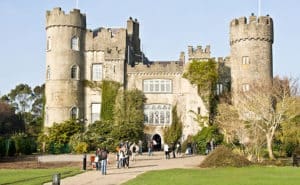Echoes of the Ancestors: Ireland’s Megalithic Monuments and Their Universal Significance

Updated On: April 30, 2024 by Raghda Elsabbagh
Ireland’s megalithic monuments are a testament to the island’s ancient past and its place within the broader narrative of prehistoric constructions around the world. These structures span a chronology that bridges thousands of years, offering a glimpse into the lives, beliefs, and engineering prowess of our Neolithic ancestors. From dolmens and passage tombs to stone circles, each monument weaves a story of cultural and ritual significance that resonates through time. They not only reflect the societies that built them but also Ireland’s significant role in the grand tapestry of megalithic traditions.
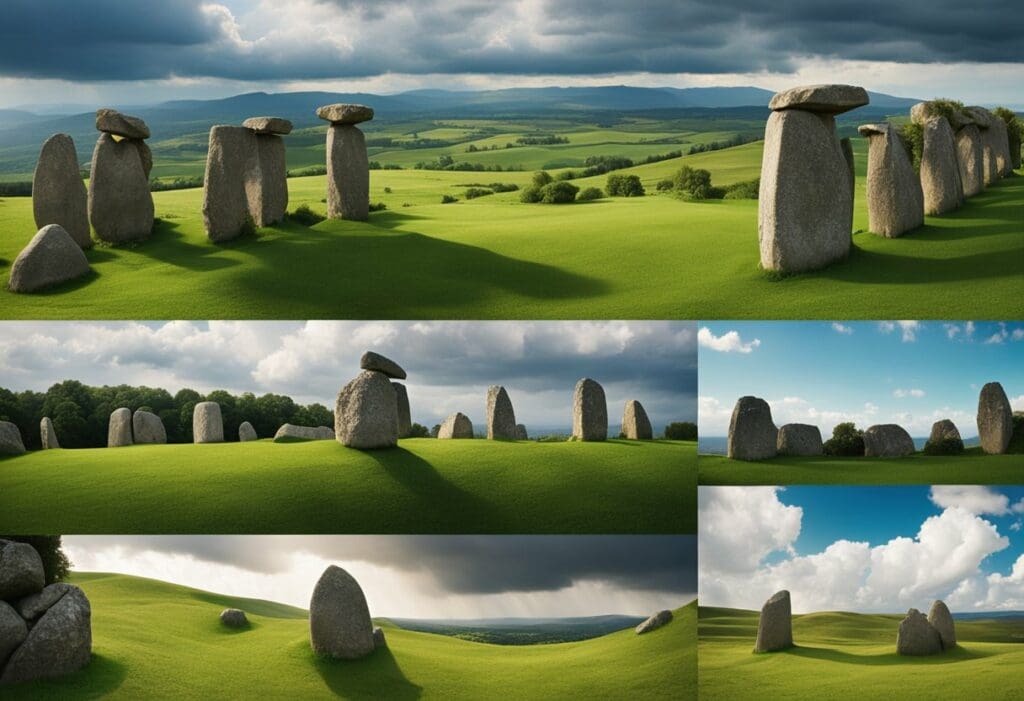
Our understanding of these ancient structures is deepened by archaeological excavations and studies that explore their construction, alignment, and purpose. Complexes like Newgrange and the tombs of Carrowkeel illuminate the sophisticated knowledge of astronomy and the precise engineering skills of their builders. These age-old monuments, set against Ireland’s dramatic landscapes, are a powerful link to the past and continue to capture the imaginations of both locals and visitors alike. As stewards of such heritage, we are tasked with ensuring their preservation and integrating them responsibly into modern tourism, thus allowing them to echo the voices of our ancestors into the future.
Table of Contents
Ireland’s Position in Megalithic Traditions
Megalithic monuments are a significant aspect of the prehistoric landscape across Europe, and Ireland holds a pivotal place in this wider tradition. Our island is home to some of the most compelling and well-preserved megalithic sites, which are testaments to the ingenuity of Neolithic societies.
In Ireland, these monuments are primarily clustered in the western and northern regions, where they were built to align with astronomical phenomena. The megalithic tombs have varying structural forms, including passage tombs, court tombs, dolmens, and wedge tombs. Notable among them are the passage tombs at Brú na Bóinne, which incorporate elaborate stone carvings and astronomical alignments, often solstitial.
- Newgrange: A UNESCO World Heritage site renowned for its winter solstice illumination.
- Carrowmore: Comprises one of the largest concentrations of megalithic tombs in Ireland.
These structures reveal a sophisticated understanding of both engineering and astronomy, reflecting the deep-seated cultural and spiritual beliefs of the people. Our Irish passage tomb tradition has parallels across Atlantic Europe, where similar megalithic practices were observed, albeit with regional variations.
The construction of these monuments marks a transition from nomadic lifestyles to sedentarism, brought about by the advent of farming. It is the mastery over the landscape, evidenced by our ancestors’ ability to transport and erect massive stones, that underscores a yearning for continuity and a connection with the cosmos.
Ireland’s megalithic monuments not only contribute to the rich tapestry of our national heritage but also provide an invaluable insight into the wider megalithic phenomena in Europe. Through them, we gain an understanding of how our ancestors shaped their beliefs, communities, and the very landscape we continue to inhabit today.
Chronology of Ireland’s Megalithic Monuments
The construction of megalithic monuments marks a pivotal era in human history. Stone Age humans began erecting these structures with the onset of the Neolithic period, transitioning from nomadic lifestyles to more settled societies.
Ireland’s megalithic monuments are evidence of this transition. The earliest megalithic tombs in Ireland, known as court cairns, date from around 4000 BCE. Passage tombs followed, featuring elaborate designs, with the most famous Newgrange dating back to approximately 3200 BCE.
| Period | Event |
|---|---|
| Neolithic | Initial construction of megalithic tombs (circa 4000 BCE) |
| Neolithic | Newgrange passage tomb established (circa 3200 BCE) |
| Bronze Age | Transitional period bringing advancements in metalworking (from circa 2500 BCE) |
During the Bronze Age, which commenced around 2500 BCE, we see a shift with new technologies influencing burial practices. Megaliths remained in use, but there was an evolution in the style and purpose of these monuments.
These megalithic structures were not mere burial places; they held ceremonial significance and stood as a testament to the skills and beliefs of their builders. The sophisticated understanding of astronomy and geometry in megalithic Ireland is exemplified by the winter solstice alignment at Newgrange, where sunlight illuminates the inner chamber.
Our ancestors in Ireland engaged in the practice of constructing these monuments for well over a thousand years, with the tradition fading as societal and cultural shifts marked the end of the Bronze Age. These ancient megaliths have stood the test of time, providing us with profound insights into our collective past.
Landscape and Geography of Ireland’s Megalithic Monuments
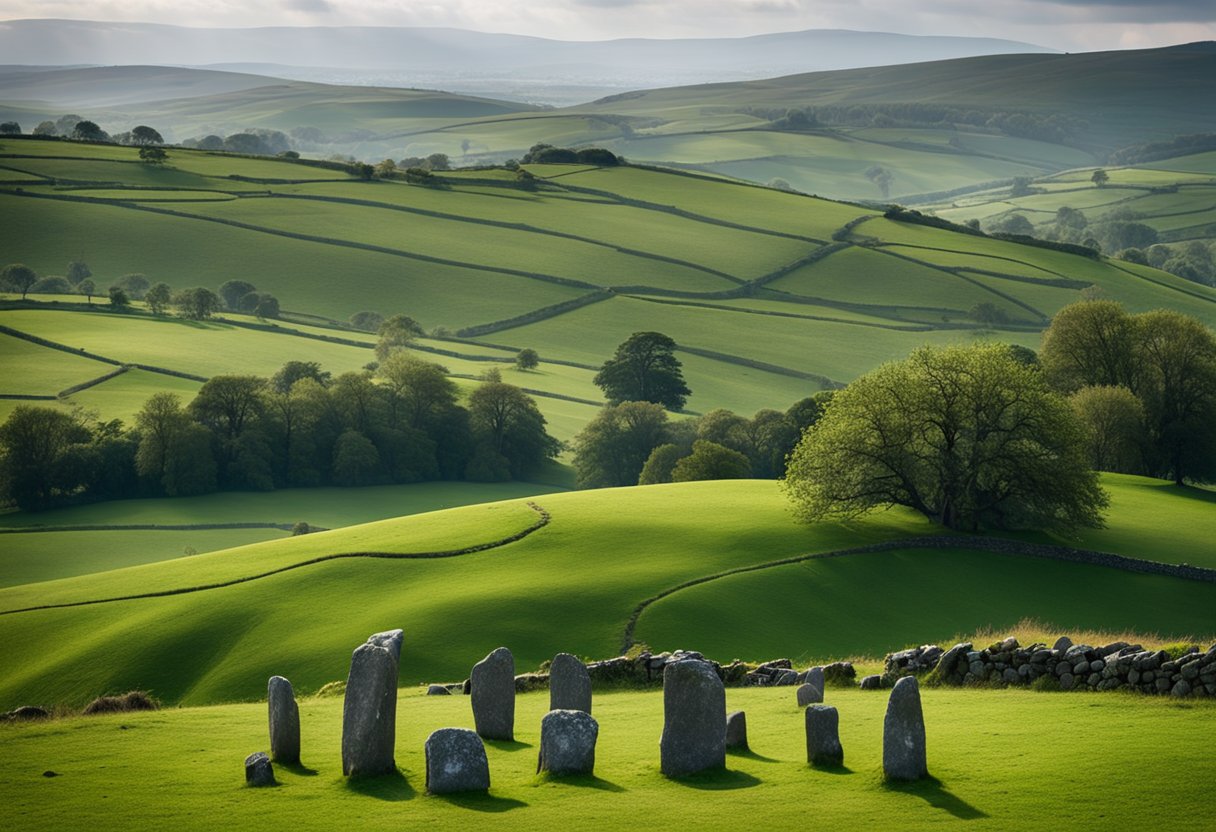
Ireland’s megalithic monuments are not randomly scattered but are intricately connected to the landscape and geography of the region. The physical setting of these ancient structures offers insights into the practices and beliefs of Neolithic societies.
Regional Distributions
Irish megalithic monuments are concentrated in regions that held particular significance for ancient communities. In County Meath, we find the UNESCO World Heritage Site of Brú na Bóinne, where passage tombs like Newgrange are strategically placed. Down to County Cork and further up to counties like Armagh and Clare, each region houses these megalithic wonders. Dublin, though now a bustling capital, also has its share of ancient monuments.
Further north, in County Donegal and down to the wild landscape of County Mayo, the remnants of Ireland’s ancestors are prominent. Eastern counties like Louth and Carlow, and even as far as Fermanagh and Tyrone, continue this pattern. Each county’s coordinates bear testimony to a civilisation that revered their dead, aligning tombs with astronomical events and terrestrial landmarks.
Geological Formations
The geological formations across Ireland provided the raw materials for these structures, often reflecting regional variances. For instance, the large granite boulders used in the construction of the portal tombs in County Clare differ from the limestone slabs found in tombs in County Sligo. Monaghan’s drumlins and Kilkenny’s limestone-rich lands influenced the construction and location of megaliths. At the coastal edges like Clifden in County Galway, the rugged terrain offers a different backdrop to monuments compared to the rolling plains of Limerick. This diversity in geology informed the design of the monuments and the ritualistic landscapes that surrounded them, embedding these megaliths within the tapestry of Ireland’s natural heritage.
Types of Ireland’s Megalithic Monuments
In exploring Ireland’s ancient landscapes, we encounter the silent but eloquent relics of prehistoric times—the megalithic monuments. A testament to the ingenuity of our ancestors, these structures range from communal tombs to solitary standing stones.
Passage Tombs
Passage tombs are some of the most famous megaliths, characterised by a narrow passageway leading to a central chamber. They are often encircled with kerbstones and covered by cairns. The best-known example, Newgrange, is a passage tomb renowned for the illumination of its inner chamber by the winter solstice sunrise.
Court Tombs
These monuments, recognisable by their open, rectangular courtyard leading to a burial chamber or chambers, are among the oldest in Ireland. Court tombs, such as those found at Creevykeel, often contain evidence of communal burials and ritual activity.
Wedge Tombs
Wedge tombs, named for their narrowing layout from the entrance to the back, are dated to the Late Neolithic and Early Bronze Age. They can be found distributed mostly in the western part of Ireland, with the Ballyedmonduff wedge tomb being a notable example.
Portal Tombs
Known for their imposing entrance formed by two large upright stones and a capstone, portal tombs are impressive megalithic structures. Also referred to as dolmens, these tombs, such as the Poulnabrone in County Clare, are iconic features of the Irish Neolithic landscape.
Standing Stones and Stone Circles
Standing stones, either solitary or as part of stone circles, evoke contemplation of their purpose—be it ceremonial, territorial, or astronomical. The Ring of Brodgar in Orkney stands as a magnificent example of a stone circle, showcasing the breadth of these ancient traditions across the British Isles.
Significant Monuments and Complexes
In exploring Ireland’s ancient past, we discover a landscape punctuated by remarkable megalithic sites, each with its own history and alignment with the cosmos. These monuments stand as a testament to our ancestors’ deep connection with the land and the skies.
Newgrange and Brú na Bóinne
The Newgrange monument, part of the Brú na Bóinne complex, is arguably Ireland’s most famous prehistoric site. Built around 3200 BC, it predates both Stonehenge and the Egyptian pyramids. This passage tomb is renowned for its winter solstice phenomenon, where the inner chamber is illuminated by the sunrise, symbolically marking the rebirth of the year.
Knowth and Dowth
Adjacent to Newgrange, Knowth and Dowth are also part of the Brú na Bóinne complex. Knowth is notable for having the greatest concentration of megalithic art in Western Europe. It features two passages aligned with the equinoxes. Dowth, often less celebrated, holds its own mysteries with alignments to the setting sun on the shortest day of the year, revealing the intricate understanding our ancestors had of astronomy.
Loughcrew and Carrowmore
Further afield, the Loughcrew Cairns and the Carrowmore megalithic complex highlight a different aspect of megalithic architecture. ‘Cairn T’, at Loughcrew, is particularly fascinating. It illustrates complex engineering skills with an inner chamber aligned with the sunrise on the vernal and autumnal equinoxes. Carrowmore in County Sligo is among the oldest such complexes; its central tomb has been dated back to 4600 BC, reiterating the significance of these structures in Neolithic Ireland.
Poulnabrone and Knocknarea
Lastly, Poulnabrone Dolmen in the Burren and Knocknarea in County Sligo enrich our knowledge of the multifaceted megalithic tradition. Poulnabrone Dolmen, a portal tomb from around 4,000 to 3,000 BC, is an iconic feature of the limestone landscape of the Burren, providing crucial insights into the burial practices of our Neolithic ancestors. Meanwhile, Knocknarea is said to be the resting place of Queen Maeve of Connacht, under a great cairn, adding a layer of myth and legend to our understanding of these ancient monuments.
Archaeology and Excavation
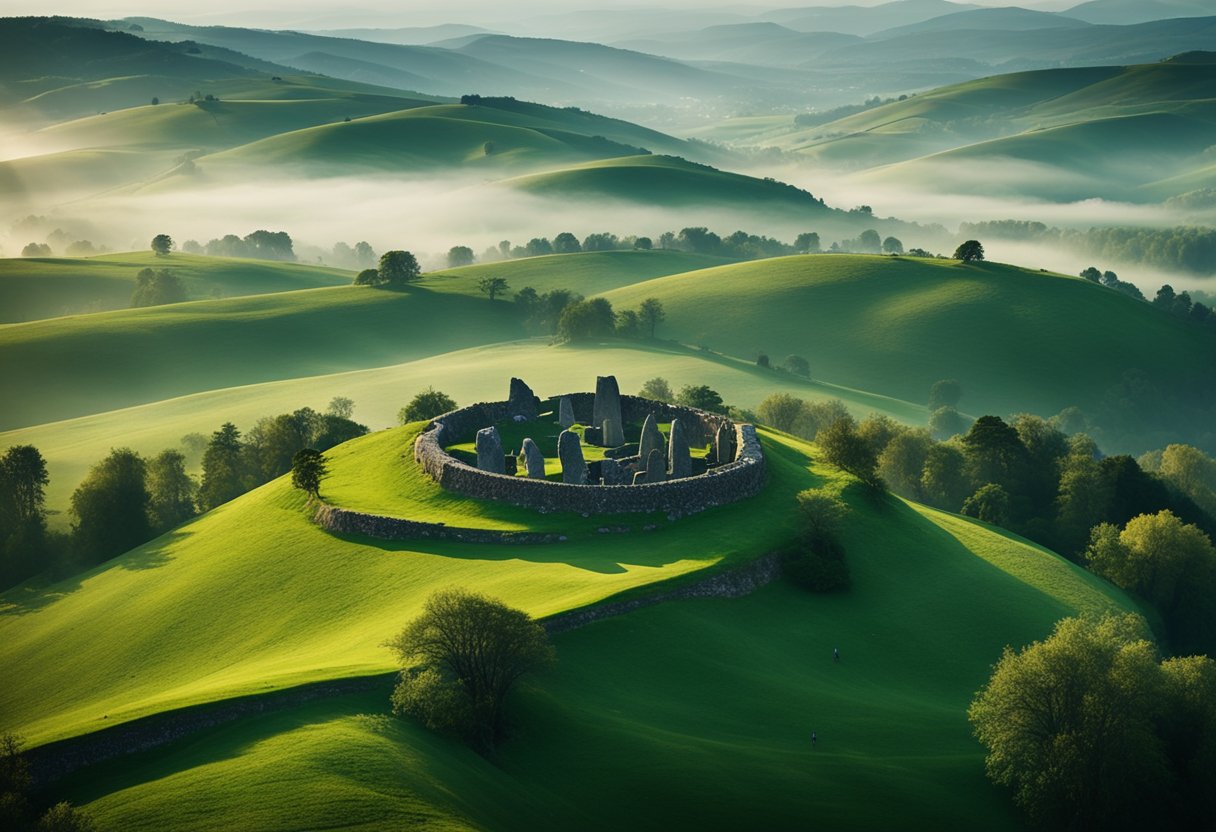
As we unpack the history of Ireland’s megalithic structures, it’s essential to understand the archaeological methods and discoveries that have brought us closer to our ancestors. Through meticulous excavations, researchers have unveiled artefacts and employed advanced dating techniques that shed light on the ancient civilisations that once inhabited these lands.
Dating Techniques
In the study of megalithic monuments, such as the iconic Poulnabrone Dolmen, chronometric dating is crucial. Radiocarbon dating of organic materials, like flint or charcoal found within a burial, is often used to estimate the age of cists – small stone-built coffin-like boxes. This method has securely dated Poulnabrone and other sites to the Neolithic period.
Another technique, optically stimulated luminescence (OSL), helps date the last time sediment was exposed to sunlight, providing clues about the construction and use of megalithic tombs. Thermoluminescence (TL) dating, on the other hand, is typically employed to date ceramics or fired materials associated with the monuments.
Archaeological Findings
Excavation of megalithic sites often reveals a treasure trove of artefacts that unfold the narrative of Neolithic Ireland. Important findings can include:
- Flint tools: Indicative of daily life and rituals.
- Pottery shards: Offering insights into domestic use and ceremonial practices.
Excavations have also illuminated the use of cists within larger burial complexes. At the aforementioned Poulnabrone tomb, for example, the well-preserved cist revealed significant human remains and burial gifts.
In Ireland’s megalithic monuments context, monuments serve as a testament to the society’s architectural prowess and spiritual beliefs. Unearthing these sites allows us to appreciate the sophistication of their creators, whose legacy in stone has spanned millennia.
Construction and Engineering
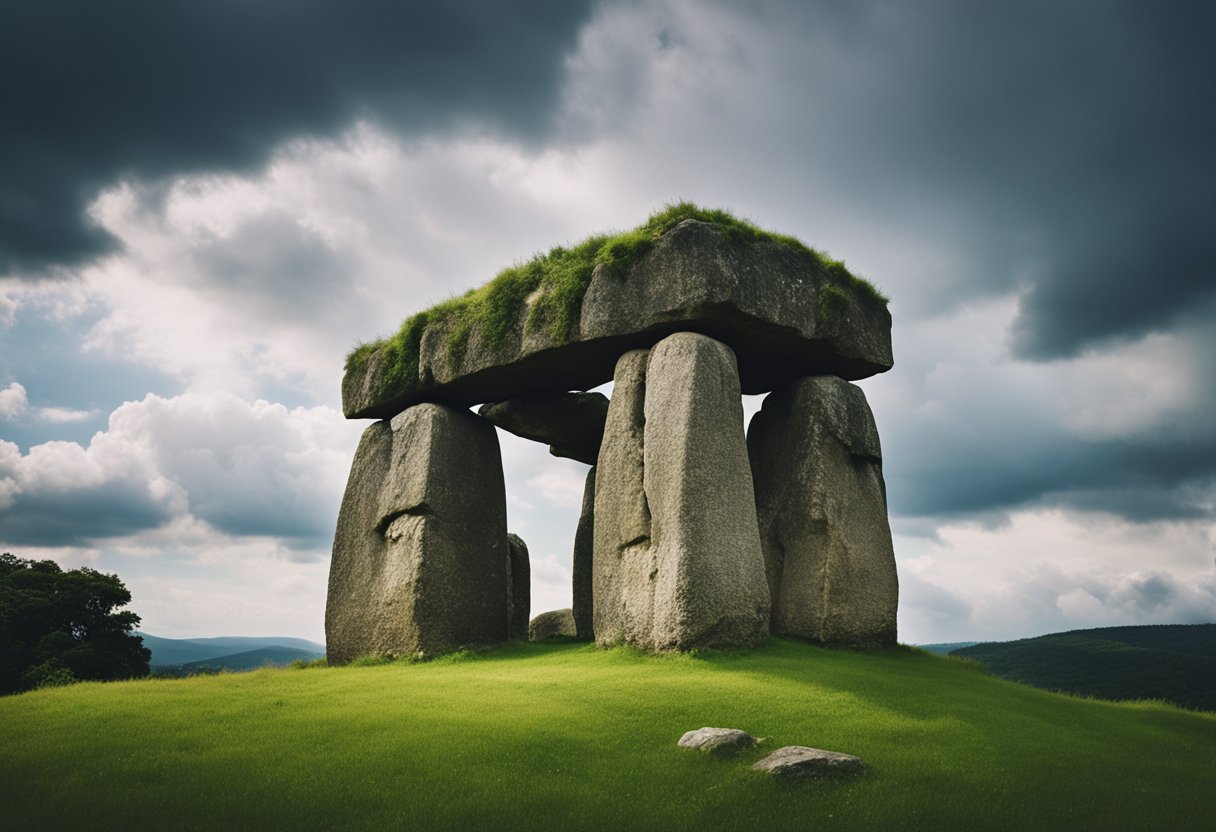
In the realm of ancient structures, the construction and engineering of Ireland’s megalithic monuments display an advanced understanding of stonework and design.
Structural Features
The structural elements of megalithic monuments involve several types of components. Chambers, typically found at the core of these constructions, were often built using large upright stones supporting substantial roof slabs, demonstrating the builders’ skills in creating capacious interiors. Additionally, many monuments feature external cairns and conical heaps of stones that may cover a tomb or mark a location, adding both gravitas and visibility to the monument’s physical presence.
Building Techniques
The engineering techniques employed for monolithic structures were rooted in profound practical knowledge. Builders would methodically select and transport colossal stones, aligning them with precision. As seen in Ireland’s megalithic monuments, the side walls were typically constructed using a dry stone wall technique, a method so efficient that some of these structures have withstood thousands of years. The pinnacle of their craftsmanship can be observed in how they meticulously placed upright stones and structured roof slabs to endure the passage of time without the use of mortar.
Cultural and Ritual Significance of Ireland’s Megalithic Monuments
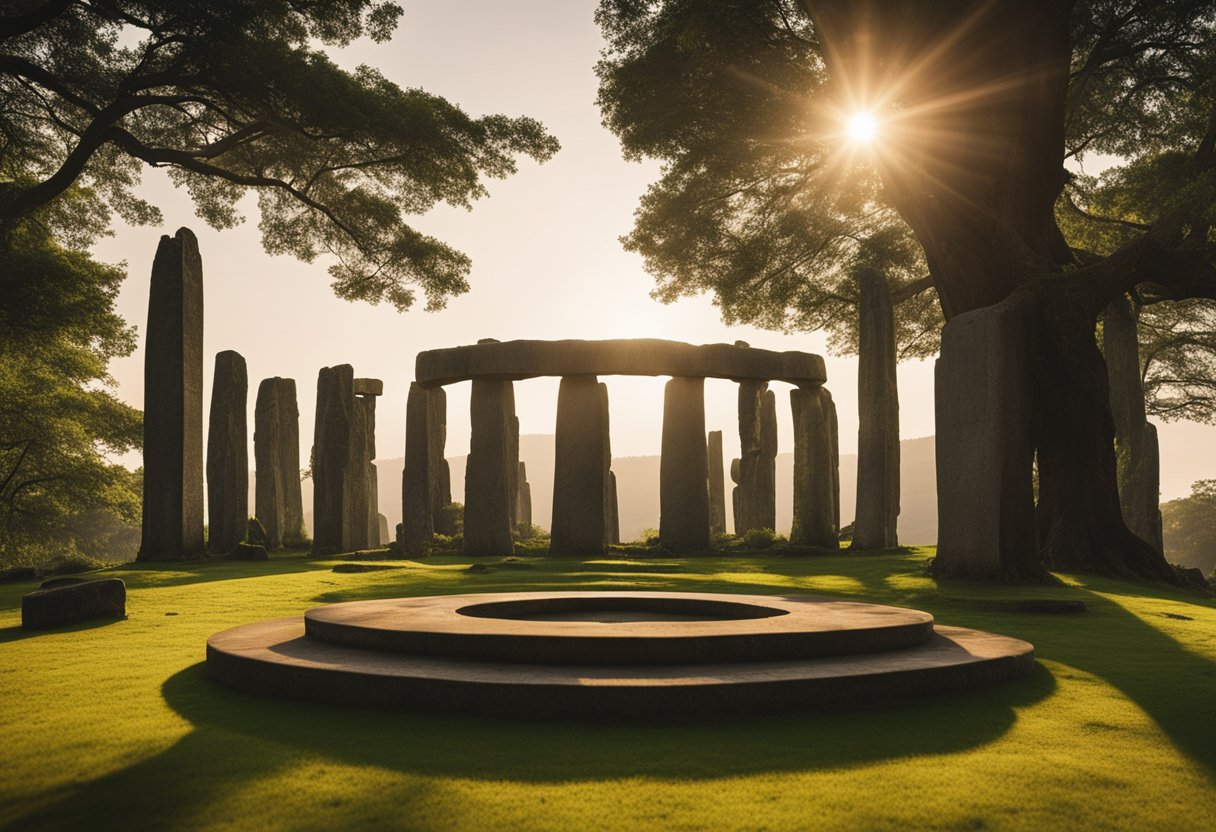
The megalithic monuments of Ireland serve as a testament to the complex spiritual and ceremonial life of our ancestors. Embedded within the stones are stories that echo through time, revealing the rituals and beliefs of societies long passed.
Ritual Practices
Megalithic monuments were focal points for ceremonial activities that tied communities to the rhythms of the natural world. In Ireland, our passage tombs—such as those at Carrowkeel and Loughcrew—were not merely burial sites but venues for elaborate rituals that likely included rites of passage, astronomical observations and celebrations of the solstices and equinoxes. Stone alignments and carvings suggest that these sites were carefully designed to mark critical points in the agricultural calendar, aligning with specific celestial events to signal to our ancestors when to sow crops and celebrate the harvest.
- Example Rituals:
- Solstice observations
- Communal gatherings
- Ancestral worship
Symbolism and Mythology
The enigmatic carvings and structural orientations of monuments such as Newgrange or the stone circles in County Cork embody a rich tapestry of symbolism and mythology. Often featuring spirals, circles, and zigzag patterns, these megaliths communicate a reverence for nature and a connection to the mysteries of life and death. Mythological tales associated with these sites, passed down over generations, speak of gods, heroes, and a deep mystic significance that transcended mere physical existence. Celtic myths, in particular, imbued these monuments with storied pasts, intertwining the destiny of kings and warriors with the stones themselves.
- Examples of Symbolic Elements:
- Spirals: Cycle of life, the sun, rebirth
- Triangles: Trinity concepts, strength
- Zigzags: Water, serpents, renewal
Alignments and Astronomical Observations
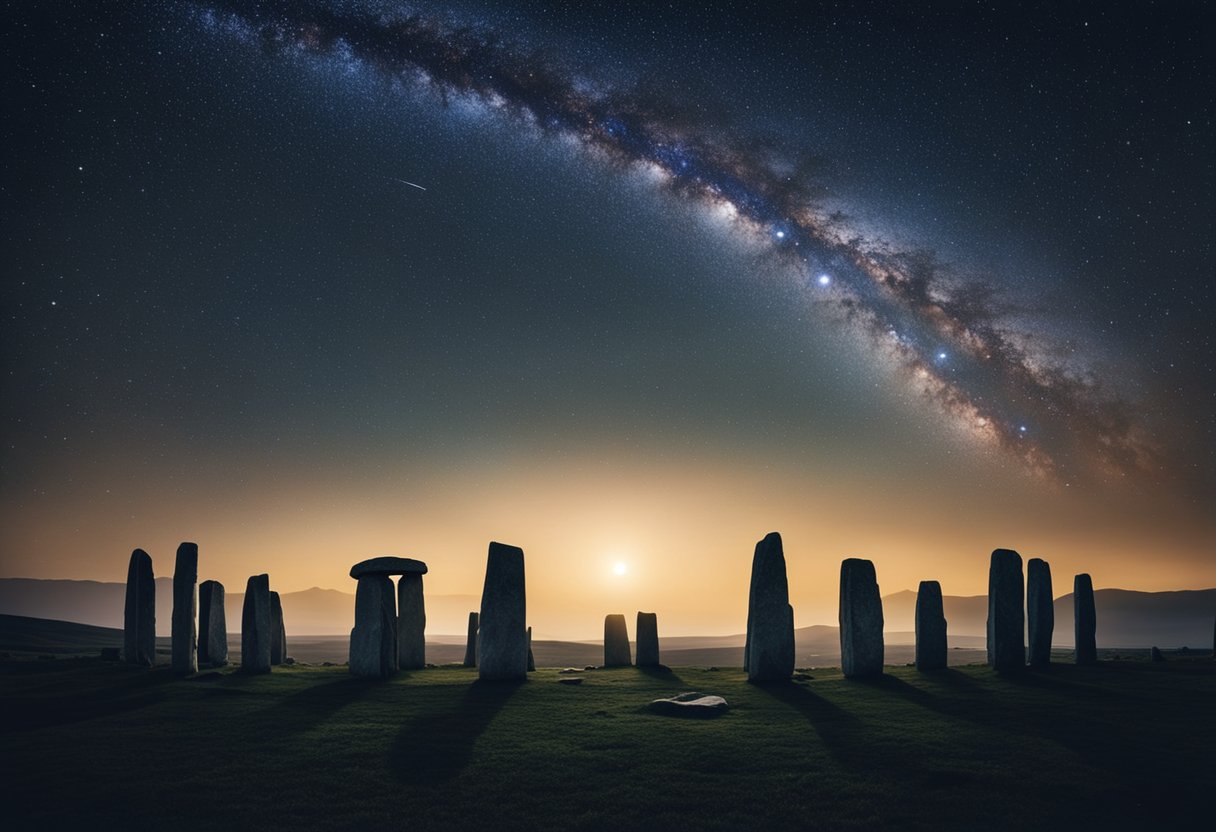
In exploring Ireland’s megalithic monuments, we find that these structures are not only feats of engineering but also sophisticated calendars marking celestial events such as the winter solstice.
Solar and Lunar Alignments
Irish megalithic structures like Newgrange clearly demonstrate the importance of solar alignments to our ancestors. The inner chamber of Newgrange is famously illuminated by the sun, specifically during the winter solstice, revealing a profound connection with the solar cycle. Similarly, the standing stones at Baltray are known to align with the Rockabill islands, underscoring a deliberate astronomical link. Discoveries at these sites confirm that solar and lunar cycles were pivotal in the design and orientation of these ancient monuments.
Astronomical Theories
Our comprehension of these ancient sites is enhanced by considering various astronomical theories. One prevailing theory posits that some megalithic tombs in Ireland align not only with solar events but also lunar standstills, which occur far less frequently. At certain sites, such as the ones near Oldcastle in County Meath, there is evidence suggesting that alignments with both the sun and moon were intended to track complex lunar cycles, embedding sophisticated observations and understandings of the cosmos within the architecture of these structures.
Preservation and Tourism
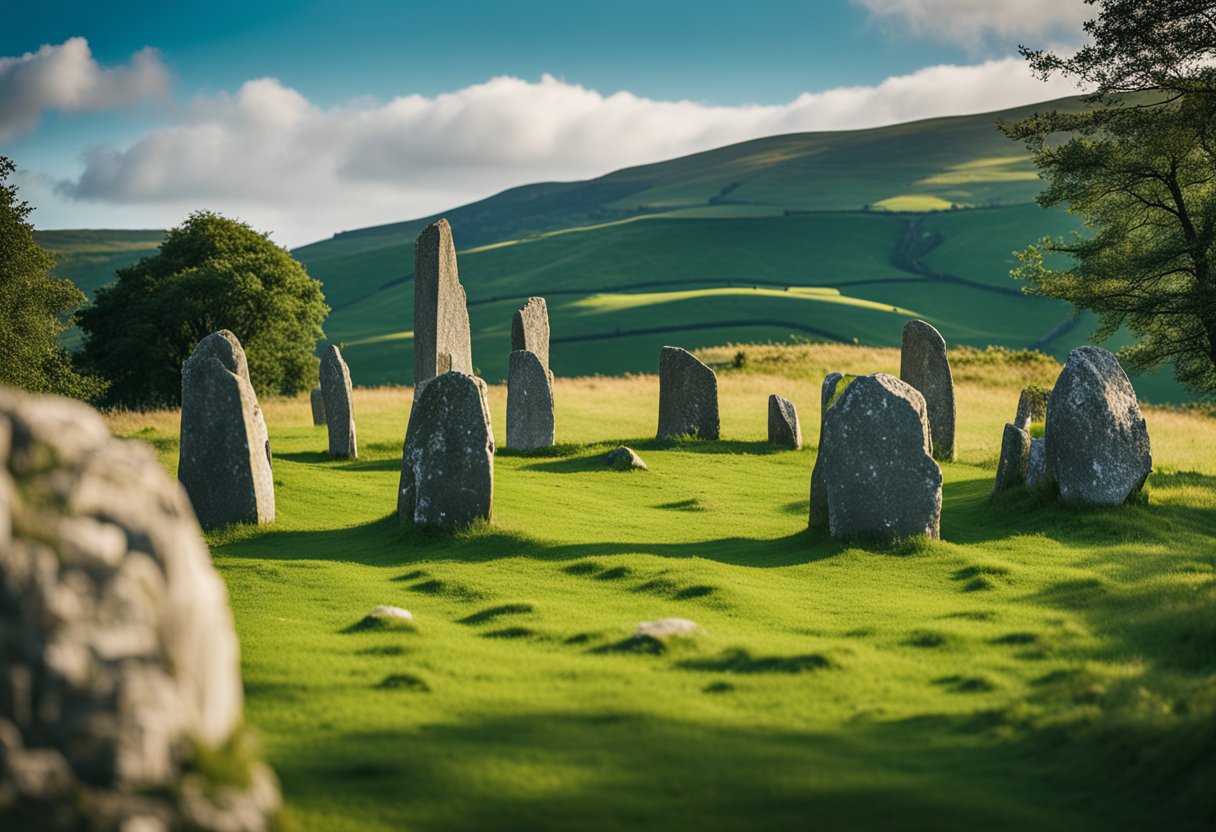
In our discussion on Ireland’s megalithic monuments, it is imperative to consider the symbiotic relationship between preservation and tourism. We acknowledge that responsible stewardship of these ancient sites ensures they can be both an educational resource and a cultural attraction for generations to come.
Conservation Efforts
The sustainability of megalithic tombs and passage graves in Ireland hinges on ongoing conservation efforts. Organisations, both governmental and non-governmental, endeavour to maintain the structural integrity of these historic sites. Methods include regular monitoring for environmental damage, implementing remedial works to forestall decay, and enacting protective legislation that guards against the adverse effects of human interaction and natural wear. These actions are essential to prevent the loss of insight into our Neolithic heritage.
Public Access and Education
Enhancing public access to megalithic sites strikes a balance between showcasing their historical value and preserving their condition. We create interpretative centres and marked trails, ensuring visitors can appreciate the significance of a passage grave without causing harm. At the same time, educational programmes aim to engender a sense of stewardship in both local residents and international tourists. By informing the public about the importance of conservation, we foster sustainable tourism practices that respect our shared cultural legacy.
Contemporary Reflections
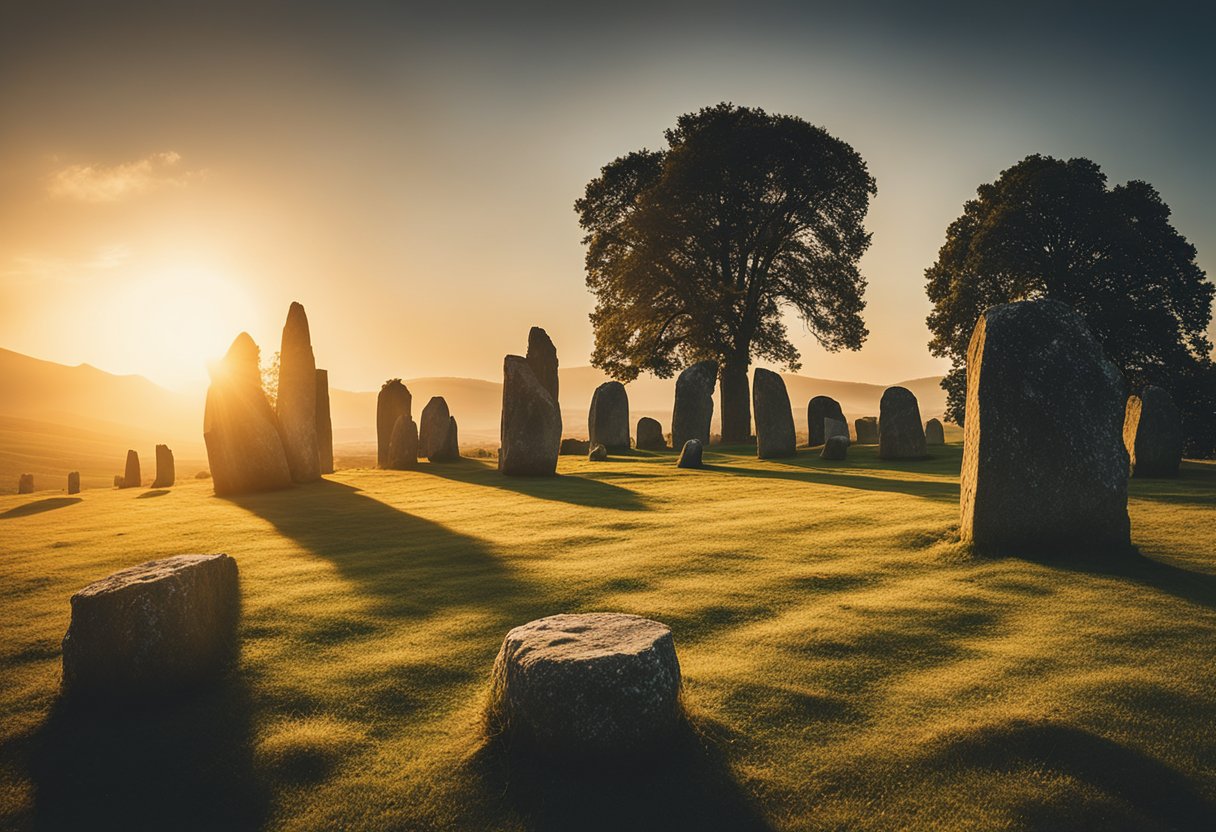
In our engagement with Ireland’s heritage, we’ve observed the profound resonance that megalithic monuments impart to both academic scholars and casual visitors alike. Their widespread presence across the Irish landscape, such as the megalithic tombs of Brú na Bóinne or the standing stones at Carrowkeel, serves not only as a testament to the ingenuity of Neolithic societies but also as a canvas for contemporary reflection. Through these enduring stone structures, we glimpse the shared human endeavour to make sense of our place in the universe.
Through megalithic Ireland, modern minds confront the mysteries of past civilisations. The silent stones prompt us to consider the lives and beliefs of those who have gone before us. Whether reflecting on the alignment of these monuments with astronomical events or appreciating the sheer scale of manual endeavour involved in their construction, we are invariably led to ponder the continuity of human existence.
Our insights are shaped not only by the physical remnants but by the stories and traditions that swirl around them. Megalithic sites often find themselves steeped in local folklore, imbuing them with a life that extends beyond the academic and into the spiritual and the mystic.
In appreciating these sites, we are engaging with a key aspect of our work at Connolly Cove: respecting the cultural and historical significance of such places while promoting sustainable tourism. By encouraging a thoughtful approach to engagement with these ancient sites, our aim is to ensure that they endure for future generations to marvel at and learn from, just as we do today.
In this light, Ireland’s megalithic monuments stand not just as relics of antiquity but as powerful, living symbols of heritage. They offer each of us a chance to reflect on our collective human journey and the indelible mark it leaves upon the earth.
Frequently Asked Questions
In delving into Ireland’s megalithic monuments, we encounter a tapestry of ancient wisdom and architectural prowess. These structures not only reveal our ancestors’ ingenuity but also their profound connection to the cosmos and the land.
What is the significance behind the construction of Megalithic monuments in Ireland?
Megalithic monuments in Ireland are archaic embodiments of spiritual, astronomical, and communal importance. They’ve been linked to ritualistic activities and are thought to reflect a deep concern for the afterlife, widely evident in their alignment with astronomical phenomena.
How do the functions of menhirs differ from other megalithic structures?
Menhirs, or standing stones, often serve as solitary markers and may represent territorial claims or commemorative purposes. Unlike the burial functions of passage tombs, they do not typically form part of larger ceremonial complexes.
In what ways did ancient societies use megalithic monuments?
Ancient societies utilised megalithic monuments for a variety of purposes, including as burial sites, territorial markers, and ceremonial or cosmological symbols, reflecting their complex societal structures and beliefs.
What are the defining features of Megalithic sites in Ireland compared to those in other regions of Europe?
Ireland’s megalithic sites are characterised by their diverse range, from passage tombs to dolmens, with remarkable features such as spiralled art and cosmic alignments. While sharing similarities with European sites, their distinct artistic expressions and construction techniques offer unique insights into Irish Neolithic society.
How does the architecture of Newgrange represent the broader megalithic tradition?
Newgrange stands as a brilliant testament to the broader megalithic tradition with its precise alignment to the winter solstice, elaborately engraved stones, and sophisticated construction, representing a pinnacle of Neolithic craftsmanship.
What are some of the commonalities shared by European Megalithic monuments in their design or purpose?
Across Europe, megalithic monuments often share commonalities in design, such as the use of large stone slabs, and purpose, where they function as communal burial sites or align with celestial bodies, revealing a pan-European preoccupation with death, ancestry, and the universe.



